Reproduction of ficus Benjamin: methods and tips for care

Ficus Benjamin is loved by many for a reason. This evergreen tree has a beautiful crown, which designers give a variety of shapes with the help of a haircut.
By planting several layers in one large flower bed, you can create a very beautiful composition of intertwined trunks over the course of several years. If you already have an adult ficus, then you do not need to buy young plants to create such an interesting decorative element. It is much easier and more economical to multiply them yourself.



Peculiarities
The plant is relatively unpretentious. It does not require any specific maintenance. Reproduction of ficus Benjamin can be done in three different ways. They will need cuttings, cuttings or seeds.
To propagate a tree at home, you need to choose the optimal time for this, that is, when the ficus is in a state of active growth. It's spring or summer. Due to the fact that during this period the root system is growing rapidly, the procedure will almost always be successful. It is possible to grow a full-fledged plant, even if there is only one bud on the handle.
If you choose the cutting method, then pay attention to the state of the ficus itself. He must be absolutely healthy - after the cuttings are taken, the plant will need internal strength and reserves to recover. For a patient with ficus Benjamin, this will be a stressful situation.



The ways
The easiest way is grafting. Even a novice florist with minimal knowledge can handle it. The main thing is to complete all actions step by step, observing the sequence, preparatory measures and further care.
Cuttings
Initially, you need to take a scion containing a maximum of 5 internodes. The length of the cutting, which is taken for propagation, should be 15-17 cm. Too large a shoot will have small roots.
The stalk should not be very young, but semi-lignified. Cut it obliquely to make a sharp corner. For this procedure, use a sharp knife, otherwise the plant tissue on the cut will "crumple" and the roots will not appear. Leave 3 sheets on the layer, the rest must be cut off. To make the roots form intensively, make several cuts.
Place the cutting in water for about 8 hours, changing the water every 3 hours. This stage will relieve the cuts from clogging with milky juice, which, when dried, prevents the formation of roots. After the expiration of the prescribed period, remove and dry the layers, treat its cut with a special tool that stimulates the formation of the root system.
Place the stalk in a container of water. To prevent it from rotting, dissolve charcoal in water. You can do it differently: put a piece of wet cotton wool on the bottom of the dish. Place the stem in a lighted place out of direct sunlight, otherwise the workpiece will wither. If everything is done correctly, then after two weeks the cutting will give roots. When their length reaches several centimeters, you can start planting in the ground.
Pay attention to the variety of ficus used for propagation. In variegated varieties, roots are formed more slowly than in plants with monochromatic green foliage.

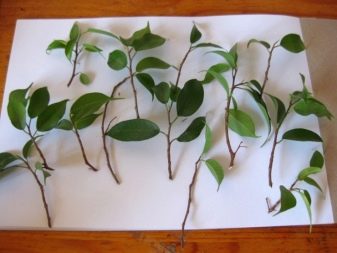

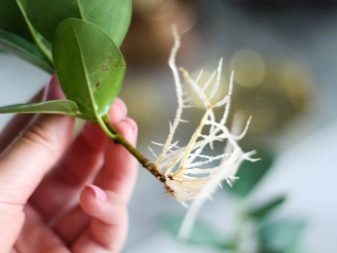
Sheet
Reproduction by the Benjamin ficus leaf differs from a similar method that is often used by lovers of violets. A fallen or simply torn leaf will not work for this.A part of the stem is cut off, on which only one leaf is located. The length of such a piece of the shoot should be about 6 cm. For cutting, we use a sharp knife.
The workpiece is slightly split and left in a glass of water for 24 hours. During this time, the milky juice will drain. After that, several cuts are made on the shoot, and it is placed in a composition that enhances the formation of roots.
Next, we place the shoot in the substrate, burying it to the base of the leaf. We cover with a transparent cap. This can be a regular jar or a cut-off base of a plastic bottle. We put such a greenhouse in a bright place. If after a month the plant gives a new leaf, then rooting has occurred.




From seed
It is possible to dilute ficus with seeds, but this is a rather laborious and ineffective activity. Therefore, this method is not popular with florists. But if you decide to try it, then before planting the seeds must be treated with a weak solution of potassium permanganate, and then soaked in a special solution that stimulates growth.
The first layer of 2 cm, which should be laid on the bottom of the container, is the drainage. The soil is poured over it, forming a pillow 10-12 cm high. The substrate intended for sowing is sterilized with steam for about an hour. Ideally, it is advisable to buy a ready-made mixture that is created specifically for ficus. It contains three components in equal parts: sand, peat and deciduous sod.
Sowing dishes should not be deep. Please note that the substrate is poured into it in such a way that 4-5 cm should remain between the layer and the edge of the dishes. It is not necessary to seal it strongly. Otherwise, the seeds will not receive enough air, moisture will stagnate, which will cause rotting.
Spread the seeds evenly. Since they are very small, use tweezers. If there are no tweezers, replace it with a wooden stick moistened with water - the seed will easily stick to the damp surface.

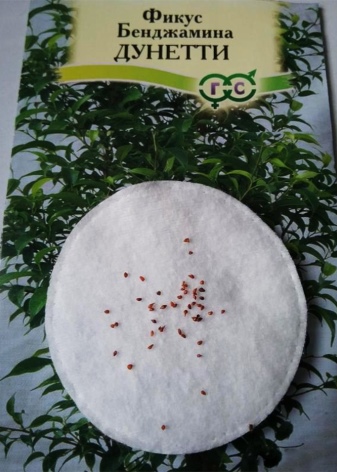
After the seeds are distributed in the pot, cover them with 5 mm of soil and moisten. A spray bottle is suitable for this procedure. You will have to use it for further watering. It will distribute moisture evenly and will not wash out the surface like a watering can.
We create a greenhouse effect: cover the container with foil or glass. In order for the seeds to germinate and not die, do not place such a mini-greenhouse in bright sunlight. The place should be light and warm. Be sure to ventilate the greenhouse. To do this, remove glass or film for a quarter of an hour 2 times a day.
When the first shoots appear, proceed with the hardening procedure. You cannot abruptly remove the protective film. Increase the retention time of the sprouts gradually.
The first true leaves appear in 1-1.5 months, but you should wait with a pick. It is permissible only after 3 months, when the plant grows strong enough. When planting, keep the height of the recess of the sprouts: do not deepen the root collar more than the level at which it was in the greenhouse container. When the plant reaches a height of 15 cm, start planting it in a separate planter.
Benjamin's ficus growing at home does not produce seeds, therefore, for this method of reproduction, you need to buy them. Please pay attention to storage conditions before purchasing.
Sow in the spring, so the emerging seedlings will have enough light. If your seeds sprout in autumn or winter, the lack of light will lead to the fact that the stems of the ficus are stretched and not strong enough.
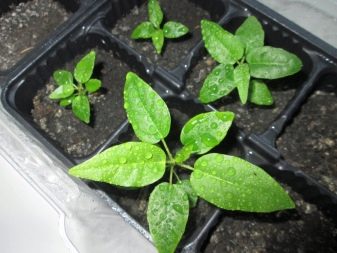

How to care?
After the plants have grown roots, you need to plant them in flower pots. To root the ficus correctly, pay attention to a few key points.
- Landing is done in a container, the bottom of which contains holes. First, the drainage is filled up. You can buy ready-made in the store or replace it with expanded clay, pebbles, pebbles.
- On top of the drainage is soil. Its layer should not reach the edge of the pot by 2-3 cm.We moisten the substrate, make a depression in it and plant the plant.
- Roots can be trimmed beforehand if they are very long. Sprinkle gently, without tamping the soil hard, so as not to damage the roots.
- The last step is watering.
To make the process as comfortable as possible, it is better to buy ready-made soil designed specifically for ficuses.
The planted plant needs proper care.
- First of all, this is the temperature regime. It is ideal if in summer temperature fluctuations are insignificant and vary from +25 to + 28 ° С. In winter, the room temperature should not drop below + 15 ° C.
- The light should be diffused and not too bright. Direct sunlight can burn the leaves.
- It is important to maintain optimal humidity: water the plant regularly, avoid overdrying or waterlogging. Spray the leaves once a week, or wipe them down with a damp soft cloth. Warm showers can be arranged in summer.
- Do not forget to periodically feed Benjamin's ficus. They start feeding when the tree is 2 years old.
- The grown plant will need to be transplanted into a larger planter. Perform the procedure in the spring, as this is the optimal time.




Florist tips
- Monitor your pet and his condition.
- Ficus Benjamin can become an object of attack by insect pests: scale insects, thrips, spider mites. As soon as you notice a deterioration in the appearance of the plant, proceed with a thorough examination, diagnosis and therapy.
- Decide immediately on the place for the ficus. A characteristic feature of the plant is the shedding of leaves when rearranged. This does not happen immediately, but about a week after you move it. The change of "place of residence" causes stress in the ficus Benjamin, as a result of which the leaves turn yellow and fall off strongly.
- Provide enough light for the ficus to look attractive. With a lack of lighting, variegated varieties can lose their rich color: white or yellow blotches will turn green.
Follow these simple tips, and the ficus will delight you for a very long time.

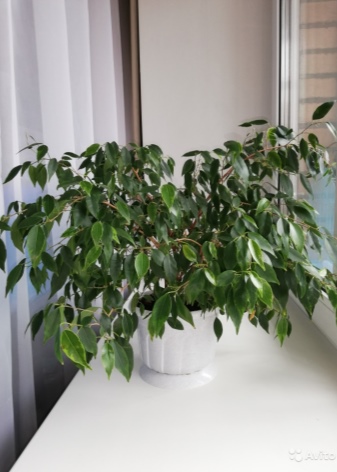
You can learn more about the reproduction of Benjamin's ficus in the next video.































The comment was sent successfully.